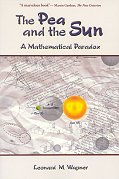The Banach-Tarski theorem states, in everyday words, that it is possible to take a sphere, partition it into a finite number of pieces, and reassemble those pieces into two spheres each the same size as the original.
What?! Doesn't that violate several laws, or something? Well, yes it would, in the physical world, but these are mathematical spheres, which can behave in apparently paradoxical ways. Wapner, in this lovely little book, builds up to the statement and proof of the theorem in a very gentle manner. By the end, you understand how the theorem could possibly be true, and why not to bother trying to use it to get rich by doubling golden balls.
It all hinges on the weird properties of infinities, which is (one of the reasons) why it doesn't work in physical reality: matter is not infinitely divisible. Wapner explains these weirdnesses, like the fact that there are just as many even numbers, or prime numbers, as there are whole numbers. This is beautifully exemplified by the Hilbert Hotel, and Wapner includes Lesser's wonderful song "Hotel Infinity" as a musical version of how this works. [And Kevin Wald's equally fine "Banned from Aleph" goes infinitely further!] He also covers some different kinds of infinities -- that there are more (infinitely more!) real numbers than whole numbers -- and the undecidability of the continuum hypothesis. Using these counter-intuitive but true ideas, he builds up to, not only a proof of the theorem, but an intuition of how it works.
After the theorem itself, Wapner provides some musings on its applicability (or lack thereof!), and the differences between physics and (pure) mathematics. Once the theorem has been understood, it is clear why it can't be used to duplicate physical objects. However, Wapner goes on to muse about duplicating regions of phase space, and speculates on the application to chaos and strange attractors. Now, phase space is a mathematical object (mapping the velocities and momenta of particles moving in real space). But I remain unconvinced: positions and momenta are quantised in physical space; nevertheless there certainly appears to be more wiggle room here.
Recommended. And for the more adventurous reader, there is always more technical detail available.

